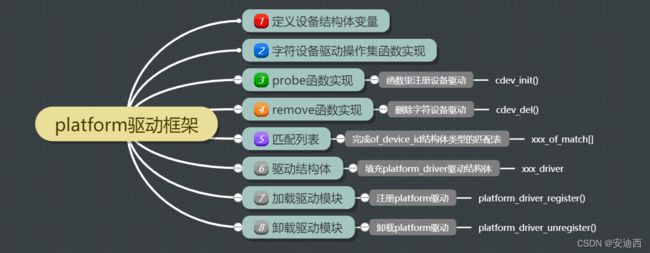Linux 下的 platform 驱动开发模板
本文介绍如何使用platform驱动框架来编写一个LED灯驱动,采用自定义platform_device的方式来编写LED的设备信息。需要编写一个驱动模块(platform驱动程序)和一个设备模块(platform设备信息)。当这两个模块都加载成功后就会匹配成功,然后platform驱动模块中的probe函数就会执行
1. platform 设备程序编写
新建设备文件leddevice.c,并根据上面的框架图,编写设备信息程序
/* 寄存器地址定义 */
#define CCM_CCGR1_BASE (0X020C406C)
#define SW_MUX_GPIO1_IO03_BASE (0X020E0068)
#define SW_PAD_GPIO1_IO03_BASE (0X020E02F4)
#define GPIO1_DR_BASE (0X0209C000)
#define GPIO1_GDIR_BASE (0X0209C004)
#define REGISTER_LENGTH 4
/* 释放 flatform 设备模块 */
static void led_release(struct device *dev) {
printk("led device released!\r\n");
}
/* 设备资源信息,即LED0所使用的所有寄存器 */
static struct resource led_resources[] = {
[0] = {
.start = CCM_CCGR1_BASE,
.end = (CCM_CCGR1_BASE + REGISTER_LENGTH - 1),
.flags = IORESOURCE_MEM,
},
[1] = {
.start = SW_MUX_GPIO1_IO03_BASE,
.end = (SW_MUX_GPIO1_IO03_BASE + REGISTER_LENGTH - 1),
.flags = IORESOURCE_MEM,
},
[2] = {
.start = SW_PAD_GPIO1_IO03_BASE,
.end = (SW_PAD_GPIO1_IO03_BASE + REGISTER_LENGTH - 1),
.flags = IORESOURCE_MEM,
},
[3] = {
.start = GPIO1_DR_BASE,
.end = (GPIO1_DR_BASE + REGISTER_LENGTH - 1),
.flags = IORESOURCE_MEM,
},
[4] = {
.start = GPIO1_GDIR_BASE,
.end = (GPIO1_GDIR_BASE + REGISTER_LENGTH - 1),
.flags = IORESOURCE_MEM,
},
};
/* platform 设备结构体 */
static struct platform_device leddevice = {
.name = "imx6ul-led",
.id = -1,
.dev = {
.release = &led_release,
},
.num_resources = ARRAY_SIZE(led_resources),
.resource = led_resources,
};
/* 设备模块加载 */
static int __init leddevice_init(void) {
return platform_device_register(&leddevice);
}
/* 设备模块注销 */
static void __exit leddevice_exit(void) {
platform_device_unregister(&leddevice);
}
module_init(leddevice_init);
module_exit(leddevice_exit);
MODULE_LICENSE("GPL");
2. platform 驱动程序编写
platform 驱动框架如下图所示:platform 驱动并不是独立于字符设备驱动、块设备驱动和网络设备驱动之外的其他种类的驱动,它只是为了驱动的分离与分层而提出来的一种框架,其驱动的具体实现还是需要字符设备驱动、块设备驱动或网络设备驱动

新建设备文件leddriver.c,并根据上面的框架图,编写驱动程序
- 宏定义及设备结构体变量定义
/* 寄存器名 */
static void __iomem *IMX6U_CCM_CCGR1;
static void __iomem *SW_MUX_GPIO1_IO03;
static void __iomem *SW_PAD_GPIO1_IO03;
static void __iomem *GPIO1_DR;
static void __iomem *GPIO1_GDIR;
/* leddev 设备结构体 */
struct leddev_dev {
dev_t devid; // 设备号
struct cdev cdev; // cdev
struct class *class; // 类
struct device *device; // 设备
int major; // 主设备号
};
struct leddev_dev leddev; // led 设备
- 字符设备驱动操作集函数实现
/* LED 打开或关闭 */
void led0_switch(u8 sta) {
u32 val = 0;
if(sta == LEDON){
val = readl(GPIO1_DR);
val &= ~(1 << 3);
writel(val, GPIO1_DR);
}else if(sta == LEDOFF){
val = readl(GPIO1_DR);
val|= (1 << 3);
writel(val, GPIO1_DR);
}
}
/* 打开设备 */
static int led_open(struct inode *inode, struct file *filp) {
filp->private_data = &leddev; // 设置私有数据
return 0;
}
/* 向设备写数据 */
static ssize_t led_write(struct file *filp, const char __user *buf, size_t cnt, loff_t *offt) {
int retvalue;
unsigned char databuf[1];
unsigned char ledstat;
retvalue = copy_from_user(databuf, buf, cnt);
if(retvalue < 0) {
return -EFAULT;
}
ledstat = databuf[0]; //获取状态值
if(ledstat == LEDON) {
led0_switch(LEDON); //打开LED灯
}else if(ledstat == LEDOFF) {
led0_switch(LEDOFF); //关闭LED灯
}
return 0;
}
/* 设备操作函数 */
static struct file_operations led_fops = {
.owner = THIS_MODULE,
.open = led_open,
.write = led_write,
};
- probe函数中,初始化IO并注册字符设备
/* platform驱动的 probe 函数 */
static int led_probe(struct platform_device *dev) {
int i = 0;
int ressize[5];
u32 val = 0;
struct resource *ledsource[5];
printk("led driver and device has matched!\r\n");
/* 1、获取资源 */
for (i = 0; i < 5; i++) {
ledsource[i] = platform_get_resource(dev, IORESOURCE_MEM, i);
if (!ledsource[i]) {
dev_err(&dev->dev, "No MEM resource for always on\n");
return -ENXIO;
}
ressize[i] = resource_size(ledsource[i]);
}
/* 2、初始化 LED */
/* 寄存器地址映射 */
IMX6U_CCM_CCGR1 = ioremap(ledsource[0]->start, ressize[0]);
SW_MUX_GPIO1_IO03 = ioremap(ledsource[1]->start, ressize[1]);
SW_PAD_GPIO1_IO03 = ioremap(ledsource[2]->start, ressize[2]);
GPIO1_DR = ioremap(ledsource[3]->start, ressize[3]);
GPIO1_GDIR = ioremap(ledsource[4]->start, ressize[4]);
val = readl(IMX6U_CCM_CCGR1);
val &= ~(3 << 26); /* 清除以前的设置 */
val |= (3 << 26); /* 设置新值 */
writel(val, IMX6U_CCM_CCGR1);
/* 设置 GPIO1_IO03 复用功能,将其复用为 GPIO1_IO03 */
writel(5, SW_MUX_GPIO1_IO03);
writel(0x10B0, SW_PAD_GPIO1_IO03);
/* 设置 GPIO1_IO03 为输出功能 */
val = readl(GPIO1_GDIR);
val &= ~(1 << 3); /* 清除以前的设置 */
val |= (1 << 3); /* 设置为输出 */
writel(val, GPIO1_GDIR);
/* 默认关闭 LED1 */
val = readl(GPIO1_DR);
val |= (1 << 3) ;
writel(val, GPIO1_DR);
/* 注册字符设备驱动 */
/*1、创建设备号 */
if (leddev.major) { /* 定义了设备号 */
leddev.devid = MKDEV(leddev.major, 0);
register_chrdev_region(leddev.devid, LEDDEV_CNT, LEDDEV_NAME);
} else { /* 没有定义设备号 */
alloc_chrdev_region(&leddev.devid, 0, LEDDEV_CNT, LEDDEV_NAME);
leddev.major = MAJOR(leddev.devid);
}
/* 2、初始化 cdev */
leddev.cdev.owner = THIS_MODULE;
cdev_init(&leddev.cdev, &led_fops);
/* 3、添加一个 cdev */
cdev_add(&leddev.cdev, leddev.devid, LEDDEV_CNT);
/* 4、创建类 */
leddev.class = class_create(THIS_MODULE, LEDDEV_NAME);
if (IS_ERR(leddev.class)) {
return PTR_ERR(leddev.class);
}
/* 5、创建设备 */
leddev.device = device_create(leddev.class, NULL, leddev.devid, NULL, LEDDEV_NAME);
if (IS_ERR(leddev.device)) {
return PTR_ERR(leddev.device);
}
return 0;
}
- remove函数中,删除设备
/* platform驱动的 remove 函数 */
static int led_remove(struct platform_device *dev) {
iounmap(IMX6U_CCM_CCGR1);
iounmap(SW_MUX_GPIO1_IO03);
iounmap(SW_PAD_GPIO1_IO03);
iounmap(GPIO1_DR);
iounmap(GPIO1_GDIR);
cdev_del(&leddev.cdev); /* 删除 cdev */
unregister_chrdev_region(leddev.devid, LEDDEV_CNT);
device_destroy(leddev.class, leddev.devid);
class_destroy(leddev.class);
return 0;
}
- 填充platform驱动结构体,name变量要与platform设备结构体的name保持一致,用于和设备匹配
/* platform 驱动结构体 */
static struct platform_driver led_driver = {
.driver = {
.name = "imx6ul-led", /* 驱动名字,用于和设备匹配 */
},
.probe = led_probe,
.remove = led_remove,
};
- 驱动入口和出口函数中,注册和卸载platform驱动
/* 驱动模块加载函数 */
static int __init leddriver_init(void) {
return platform_driver_register(&led_driver);
}
/* 驱动模块卸载函数 */
static void __exit leddriver_exit(void) {
platform_driver_unregister(&led_driver);
}
module_init(leddriver_init);
module_exit(leddriver_exit);
MODULE_LICENSE("GPL");
3. 测试程序编写
新建测试文件 platformledAPP.c,并编写程序
int main(int argc, char *argv[]) {
int fd, retvalue;
char *filename;
unsigned char databuf[2];
if(argc != 3){
printf("Error Usage!\r\n");
return -1;
}
filename = argv[1];
/* 打开 led 驱动 */
fd = open(filename, O_RDWR);
if(fd < 0){
printf("file %s open failed!\r\n", argv[1]);
return -1;
}
databuf[0] = atoi(argv[2]); /* 要执行的操作:打开或关闭 */
retvalue = write(fd, databuf, sizeof(databuf));
if(retvalue < 0){
printf("LED Control Failed!\r\n");
close(fd);
return -1;
}
retvalue = close(fd); /* 关闭文件 */
if(retvalue < 0){
printf("file %s close failed!\r\n", argv[1]);
return -1;
}
return 0;
}
4. 编译测试
- 编译驱动程序:当前目录下创建Makefile文件,并
make编译
KERNELDIR := /home/andyxi/linux/kernel/linux-imx-rel_imx_4.1.15_2.1.0_ga_andyxi
CURRENT_PATH := $(shell pwd)
obj-m := leddevice.o leddriver.o
build: kernel_modules
kernel_modules:
$(MAKE) -C $(KERNELDIR) M=$(CURRENT_PATH) modules
clean:
$(MAKE) -C $(KERNELDIR) M=$(CURRENT_PATH) clean
- 编译测试程序:无需内核参与,直接编译即可
arm-linux-gnueabihf-gcc platformledApp.c -o platformledApp
- 将两个驱动文件和测试文件拷贝至rootfs/lib/modules/4.1.15后加载驱动,加载成功后,总线就会进行匹配
depmod #第一次加载驱动时,需使用“depmod”命令
modprobe leddevice.ko
modprobe leddriver.ko
- 根文件系统中 /sys/bus/platform/ 目录下保存着当前platform总线下的设备和驱动,子目录devices为platform设备,子目录drivers为platform驱动,设备模块和驱动模块加载成功后,会在相应目录下找到对应的设备和驱动
- 使用以下命令打开或者关闭LED灯
./platformledAPP /dev/platled 1
./platformledAPP /dev/platled 0



